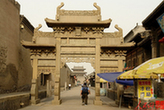The word totem comes from a Native American language, which means an image of an animal related to a group of people. A dragon and a phoenix, called Loong and Feng in Chinese respectively, are totems of the Chinese people. Belief in the dragon, and drawings of the imaginary animal, can be traced back to primitive society when prehistoric tribes in China adopted the dragon among other totems as their symbol and guardian god.
|
|
The phoenix was commonly referred to as the “King of Birds”, or a supernatural bird. It embodied the five virtues of benevolence, righteousness, propriety, wisdom, and sincerity.
|
|
The dragon and phoenix were used to decorate painted pottery and jade carvings in primitive society. The founding of the unified empire in the Qin Dynasty (221-206 BC) provided a base and motivation to develop the ancient Chinese palace architecture. Stone carvings, engraved brick, bronze ware and lacquer paintings were growing quickly. For the first time, the dragon and phoenix were heavily used on imperial architecture, especially on the imperial palaces’ roofs, beams, pillars, and doors. Chinese architecture, as a kind of oriental art, has enveloped mystery with the decoration of the dragon and phoenix.





Why not rent a boyfriend, or girlfriend to please parents during the Spring Festival?